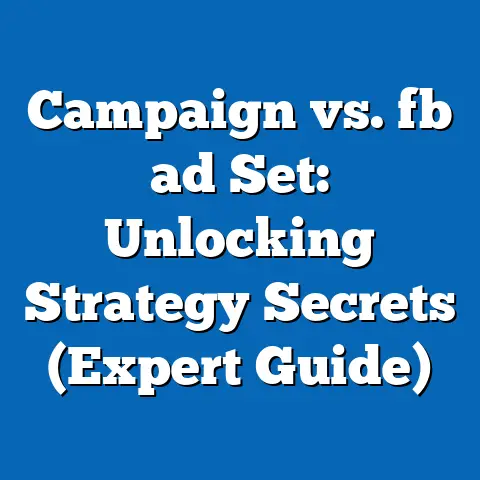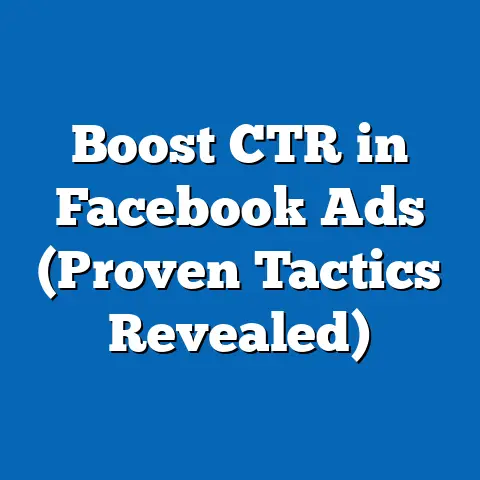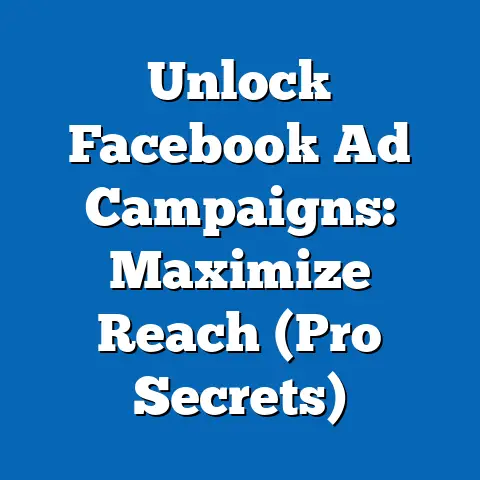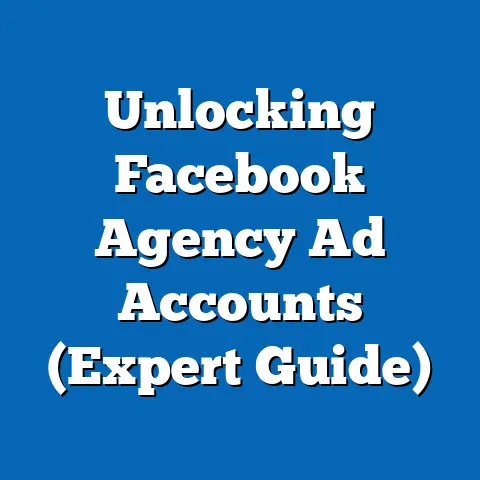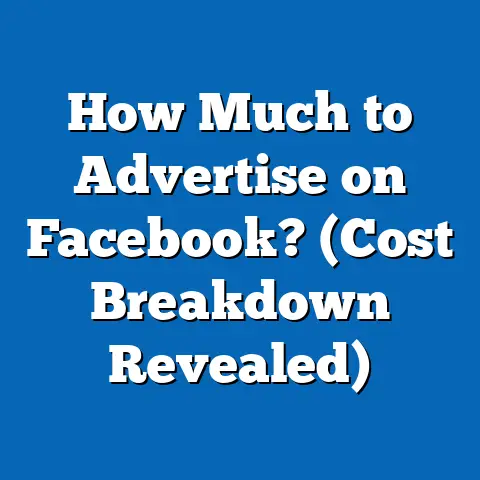Mastering Facebook Clothing Ads (Proven Strategies Inside)
Fashion. It’s more than just clothes; it’s a statement, an identity, a way of life. And while styles may come and go faster than you can say “trend alert,” one thing remains constant: the need for effective advertising. In today’s digital age, Facebook ads have become an indispensable tool for clothing brands, offering an unparalleled opportunity to connect with potential customers, drive sales, and cultivate lasting brand loyalty.
I’ve spent years helping businesses, big and small, navigate the ever-changing landscape of Facebook advertising, and I can tell you firsthand, the clothing niche is both incredibly lucrative and intensely competitive. It’s not enough to just throw up a pretty picture and hope for the best. You need a strategy, a deep understanding of your audience, and a willingness to constantly adapt and optimize.
That’s why I’ve created this guide. I’m going to walk you through the proven strategies I’ve used to help clothing brands of all sizes master Facebook advertising. We’ll dive into audience segmentation, creative design, ad features, budgeting, and performance analysis. By the end of this article, you’ll have the knowledge and tools you need to create compelling campaigns that resonate with your target audience and drive real results. Let’s get started!
Understanding Your Audience
In the world of Facebook advertising, targeting everyone is the same as targeting no one. This is especially true for clothing brands. Imagine trying to sell a bespoke suit to a teenager or a streetwear collection to a retiree. It just wouldn’t work, would it? That’s why understanding your audience is the absolute foundation of a successful Facebook ad campaign.
The Power of Segmentation
Audience segmentation involves dividing your potential customers into smaller groups based on shared characteristics. This allows you to tailor your ads to speak directly to their specific needs, interests, and desires. Think of it as having a one-on-one conversation with each potential customer, instead of shouting into a crowded room.
Here are some key factors to consider when segmenting your audience for clothing ads:
- Demographics: This includes basic information like age, gender, location, education level, and income. Are you targeting young women in urban areas with disposable income? Or perhaps middle-aged men looking for comfortable, durable clothing?
- Psychographics: This delves deeper into your audience’s values, interests, lifestyle, and personality. What are their hobbies? What brands do they admire? What kind of content do they consume online?
- Shopping Behavior: How do they shop? Do they prefer online shopping or in-store experiences? Are they price-sensitive or willing to pay a premium for quality and style? Do they frequently purchase clothing or only on special occasions?
- Interests: What are they interested in? Fashion trends, specific designers, sustainability, ethical sourcing? Aligning your ads with their interests is crucial.
Creating Customer Personas
Once you’ve gathered data on your target audience, it’s time to create customer personas. These are fictional representations of your ideal customers, based on research and data about your existing and potential customers.
For example, let’s say you’re selling sustainable, ethically sourced clothing. You might create a persona named “Eco-Conscious Emily.” Emily is a 28-year-old marketing professional living in Portland, Oregon. She’s passionate about environmental sustainability and ethical fashion. She’s willing to pay a bit more for clothing that aligns with her values. She follows ethical fashion bloggers and brands on social media and prefers to shop online.
By creating this detailed persona, you can tailor your ads to speak directly to Emily’s needs and desires. You might highlight the sustainable materials used in your clothing, the ethical manufacturing processes, and the positive impact your brand has on the environment.
Real-World Examples
I’ve seen countless clothing brands successfully leverage audience segmentation to drive results. Here are a few examples:
- A luxury menswear brand targeted high-income men in major cities with ads showcasing their bespoke suits and tailored shirts. They used Facebook’s interest targeting to reach users interested in luxury cars, fine dining, and high-end watches.
- A fast-fashion brand targeted young women with ads featuring trendy, affordable clothing. They used Facebook’s demographic targeting to reach users aged 18-25 and focused on interests like fashion, beauty, and shopping.
- An athletic apparel brand targeted fitness enthusiasts with ads showcasing their performance-enhancing clothing. They used Facebook’s interest targeting to reach users interested in running, yoga, weightlifting, and other fitness activities.
Key Takeaway: Before you even think about creating your ads, take the time to understand your audience. The more you know about them, the better you’ll be able to tailor your ads to resonate with their needs and desires.
Crafting Compelling Ad Creative
Now that you know who you’re targeting, it’s time to create ads that will grab their attention and make them want to click. In the visually-driven world of Facebook, your ad creative is absolutely critical. Think of it as your brand’s first impression – you want to make it count!
The Power of Visuals
Let’s face it, when it comes to clothing, people buy with their eyes. That’s why high-quality visuals are non-negotiable for Facebook clothing ads.
- Product Photography: Invest in professional product photography that showcases your clothing in the best possible light. Use clean backgrounds, flattering lighting, and multiple angles to highlight the details and features of your garments.
- Lifestyle Images: Show your clothing in real-world settings. Lifestyle images help your audience visualize themselves wearing your clothing and can evoke emotions and create a sense of aspiration.
- Video Content: Video is incredibly engaging and can be a powerful tool for showcasing your clothing. Create short videos that highlight the fit, movement, and texture of your garments. You can also use video to tell a story about your brand or showcase your manufacturing process. I once worked with a denim brand that saw a huge boost in engagement and sales after creating a video showing the craftsmanship that went into each pair of jeans.
Engaging Ad Copy
While visuals are important, your ad copy is what seals the deal. It’s your chance to speak directly to your audience’s needs and desires.
- Know Your Audience: Use language that resonates with your target audience. Are you targeting young, trendy shoppers? Use slang and emojis. Are you targeting a more mature audience? Use more sophisticated language.
- Highlight Benefits, Not Just Features: Don’t just list the features of your clothing. Focus on the benefits. How will your clothing make your audience feel? More confident? More comfortable? More stylish?
- Tell a Story: Use your ad copy to tell a story about your brand or your clothing. This can help create an emotional connection with your audience.
- Keep it Concise: People have short attention spans, especially on social media. Get to the point quickly and use clear, concise language.
Clear Calls-to-Action (CTAs)
Your call-to-action (CTA) is the final piece of the puzzle. It tells your audience what you want them to do next.
- Use Strong Action Verbs: Use verbs like “Shop Now,” “Learn More,” “Discover,” or “Get Yours Today.”
- Create a Sense of Urgency: Use phrases like “Limited Time Offer” or “Shop While Supplies Last” to encourage immediate action.
- Make it Prominent: Your CTA should be visually prominent and easy to click.
- Test Different CTAs: Experiment with different CTAs to see which ones perform best.
Key Takeaway: Your ad creative is the face of your brand on Facebook. Invest in high-quality visuals, write compelling ad copy, and use clear calls-to-action to grab your audience’s attention and drive results.
Leveraging Facebook’s Ad Features
Facebook offers a wide range of ad features that can help you reach your target audience and achieve your advertising goals. Understanding and leveraging these features is essential for maximizing the effectiveness of your clothing ads.
Ad Formats
- Carousel Ads: Carousel ads allow you to showcase multiple products or features in a single ad unit. This is a great option for clothing brands that want to highlight a variety of styles or collections. I’ve seen carousel ads work particularly well for showcasing complete outfits, allowing users to easily browse and purchase multiple items at once.
- Collection Ads: Collection ads are designed to create a more immersive shopping experience. They feature a large visual (either an image or video) at the top, followed by a grid of related products below. This format is ideal for showcasing your entire product catalog and driving traffic to your website.
- Dynamic Ads: Dynamic ads automatically show the most relevant products to each user based on their browsing history and interests. This is a powerful way to retarget users who have previously visited your website or viewed specific products. I’ve witnessed dynamic ads significantly increase conversion rates for clothing brands by showing users exactly what they were already interested in.
- Image and Video Ads: Simple image and video ads can still be incredibly effective, especially when paired with compelling visuals and engaging ad copy.
Targeting Options
Facebook’s targeting options are incredibly granular, allowing you to reach very specific segments of your audience.
- Lookalike Audiences: Lookalike audiences allow you to target users who are similar to your existing customers. This is a great way to expand your reach and find new customers who are likely to be interested in your clothing.
- Retargeting: Retargeting allows you to show ads to users who have previously interacted with your brand, such as visiting your website, viewing specific products, or adding items to their cart. This is a highly effective way to re-engage potential customers and drive conversions.
- Custom Audiences: Custom audiences allow you to upload your own customer data, such as email addresses or phone numbers, and target those users with your ads. This is a great way to reach your existing customers with special offers or promotions.
- Interest-Based Targeting: Target people based on their interests, hobbies, and pages they like on Facebook. This is a great way to reach people who are interested in fashion, specific clothing styles, or related topics.
Facebook Pixel
The Facebook Pixel is a small piece of code that you install on your website. It allows you to track conversions, optimize your ads, and build targeted audiences.
- Track Conversions: The Pixel allows you to track which ads are driving the most conversions, such as purchases, leads, or sign-ups.
- Optimize Ads: The Pixel helps Facebook optimize your ads to show them to the people who are most likely to convert.
- Build Targeted Audiences: The Pixel allows you to build targeted audiences based on website visitors and their behavior.
Key Takeaway: Facebook offers a wealth of ad features that can help you reach your target audience and achieve your advertising goals. Take the time to explore these features and experiment with different strategies to see what works best for your clothing brand.
Budgeting and Bidding Strategies
Setting the right budget and choosing the right bidding strategy are crucial for maximizing the ROI of your Facebook clothing ads.
Budgeting Options
- Daily Budget: A daily budget allows you to set a specific amount of money that you’re willing to spend each day on your ads. This is a good option for brands that want to maintain a consistent level of advertising throughout the month.
- Lifetime Budget: A lifetime budget allows you to set a specific amount of money that you’re willing to spend over the entire duration of your ad campaign. This is a good option for brands that have a specific advertising goal in mind and want to control their overall spending.
Bidding Strategies
- Cost-Per-Click (CPC): With CPC bidding, you pay each time someone clicks on your ad. This is a good option for brands that want to drive traffic to their website.
- Cost-Per-Thousand Impressions (CPM): With CPM bidding, you pay for every 1,000 times your ad is shown. This is a good option for brands that want to increase brand awareness.
- Cost-Per-Action (CPA): With CPA bidding, you pay each time someone takes a specific action, such as making a purchase or filling out a form. This is a good option for brands that want to drive conversions.
Allocating Your Budget
- Start Small: When you’re first starting out, it’s best to start with a small budget and gradually increase it as you see results.
- Test Different Ads: Allocate a portion of your budget to testing different ads and targeting options to see what performs best.
- Focus on High-Performing Ads: Once you’ve identified your best-performing ads, allocate more of your budget to those ads.
- Monitor Your Results: Regularly monitor your results and adjust your budget as needed.
Key Takeaway: Setting the right budget and choosing the right bidding strategy are essential for maximizing the ROI of your Facebook clothing ads. Experiment with different options to see what works best for your brand.
Analyzing and Optimizing Campaign Performance
The final step in mastering Facebook clothing ads is to continuously analyze your campaign performance and make adjustments to optimize your results. Data is your friend!
Key Performance Indicators (KPIs)
- Click-Through Rate (CTR): This measures the percentage of people who see your ad and click on it. A high CTR indicates that your ad is relevant and engaging to your target audience.
- Conversion Rate: This measures the percentage of people who click on your ad and then take a desired action, such as making a purchase or filling out a form. A high conversion rate indicates that your ad is effectively driving results.
- Return on Ad Spend (ROAS): This measures the amount of revenue you generate for every dollar you spend on advertising. A high ROAS indicates that your ad campaign is profitable.
- Cost Per Acquisition (CPA): This measures the cost of acquiring a new customer through your ad campaign. A low CPA indicates that your ad campaign is efficient.
- Reach and Frequency: Reach refers to the number of unique individuals who saw your ad. Frequency is the average number of times each person saw your ad. Balancing reach and frequency is crucial; you want to reach as many potential customers as possible without overwhelming them with the same ad.
Interpreting Data
- Look for Trends: Identify trends in your data to see what’s working and what’s not.
- Compare Different Ads: Compare the performance of different ads to see which ones are most effective.
- Segment Your Data: Segment your data by demographics, interests, and other factors to see which segments of your audience are most responsive to your ads.
- Use A/B Testing: A/B testing involves creating two versions of an ad with slight variations and then comparing their performance to see which version performs better.
Making Informed Decisions
- Adjust Your Targeting: If your ads aren’t reaching the right people, adjust your targeting options.
- Revise Your Ad Creative: If your ads aren’t engaging your audience, revise your ad creative.
- Change Your Bidding Strategy: If your ads aren’t driving conversions, change your bidding strategy.
- Refine Your Budget: If your ads aren’t profitable, refine your budget.
Key Takeaway: Data analysis is essential for optimizing your Facebook ad campaigns. Continuously monitor your results, interpret your data, and make informed decisions to improve your performance.
Conclusion
Mastering Facebook clothing ads is an ongoing process that requires dedication, experimentation, and a willingness to adapt. But by understanding your audience, crafting compelling creatives, leveraging Facebook’s features, budgeting effectively, and continuously optimizing your performance, you can create highly effective campaigns that drive real results for your clothing brand.
Remember, the fashion industry is constantly evolving, and so is the world of Facebook advertising. Stay up-to-date on the latest trends and best practices, and don’t be afraid to try new things. With a little effort and a lot of data-driven decision-making, you can unlock the full potential of Facebook advertising and grow your brand’s presence in the competitive fashion industry. I’ve seen it happen time and time again! Now, go out there and create some amazing ads!

